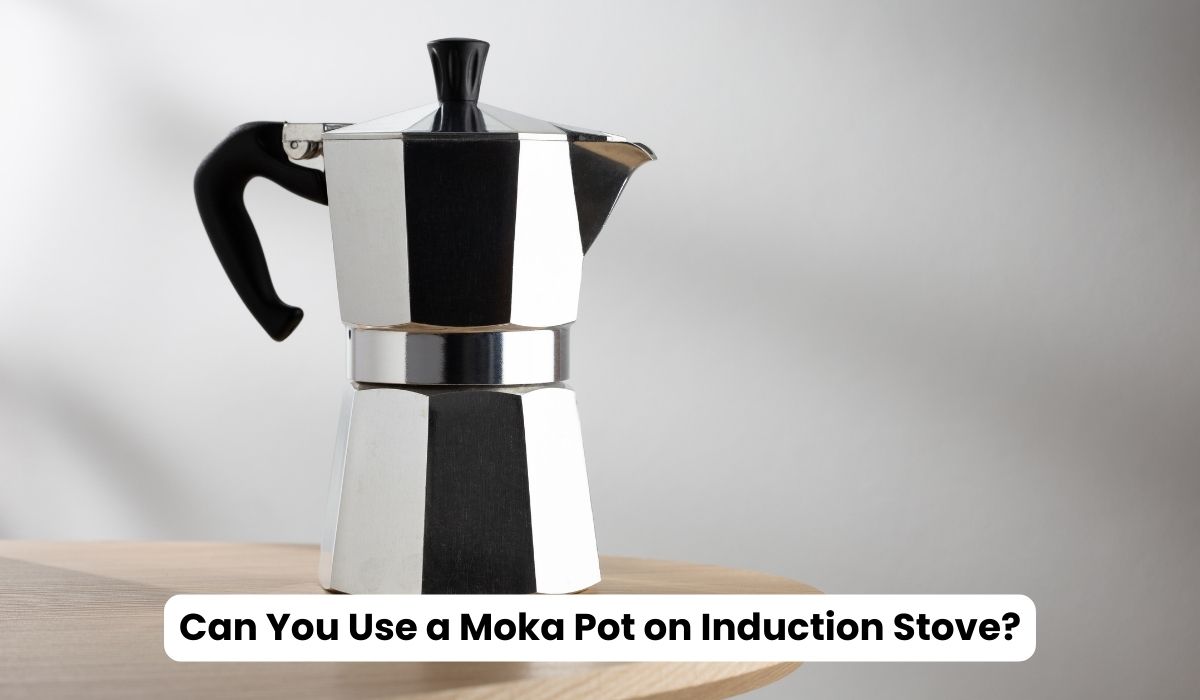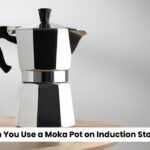If you’ve ever found yourself drawn to the creamy aromas and flavours of freshly brewed coffee, chances are you’ve explored various methods of making that perfect cup at home. Among the many options available, the Moka pot stands out for its ability to produce a robust and espresso-like brew with minimal fuss. However, for those with induction stoves, there’s often a lingering question: Can you use a Moka pot on an induction stove? It’s a common query among coffee enthusiasts looking to marry the convenience of induction cooking with the timeless charm of the Moka pot.
In this article, we’ll explore the intricacies of using a Moka pot on an induction stove, exploring its feasibility, benefits, and potential pitfalls. Whether you’re a seasoned coffee lover or a curious beginner, join us as we discover the secrets behind this beloved brewing method in the modern kitchen.
So, let’s start.
Table of Contents
How Does an Induction Stove Work:
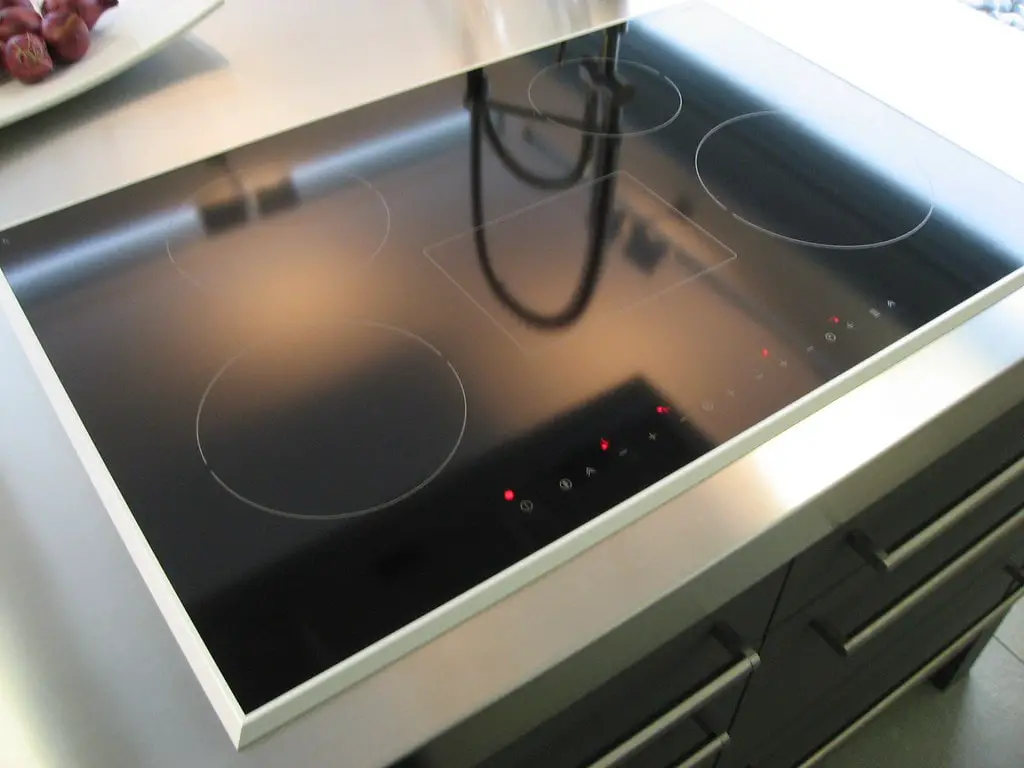
Using a Moka pot on an induction stove is a question that often arises among coffee enthusiasts. To understand the compatibility, it’s crucial to delve into how an induction stove operates.
Induction stoves rely on electromagnetic induction to generate heat directly in the cooking vessel. Unlike standard stoves that use gas or electric coils to heat a burner, an induction stove creates a magnetic field that excites iron molecules in compatible cookware, causing them to heat up.
The key factor here is that the Moka pot must be made of ferrous material, such as stainless steel or cast iron, to work on an induction stove. Aluminum or copper Moka pots won’t be effective because they lack magnetic properties.
Now, picture this: When you place your ferrous Moka pot on the induction stove, the magnetic field induces electric currents within the pot, generating heat. This heat then brews the coffee by forcing warm water through the coffee grounds, creating that rich, aromatic espresso.
The beauty of using a Moka pot on an induction stove lies in its efficiency and precision. Induction stoves offer precise temperature control, allowing you to brew your coffee at an excellent heat level for optimal flavor extraction.
Moreover, induction stoves are known for their safety features. Since the stove itself doesn’t get hot, there’s a lower risk of accidental burns. This fantastic feature adds an extra layer of safety, especially when handling hot Moka pots.
Can You Use a Moka Pot on Induction Stove?
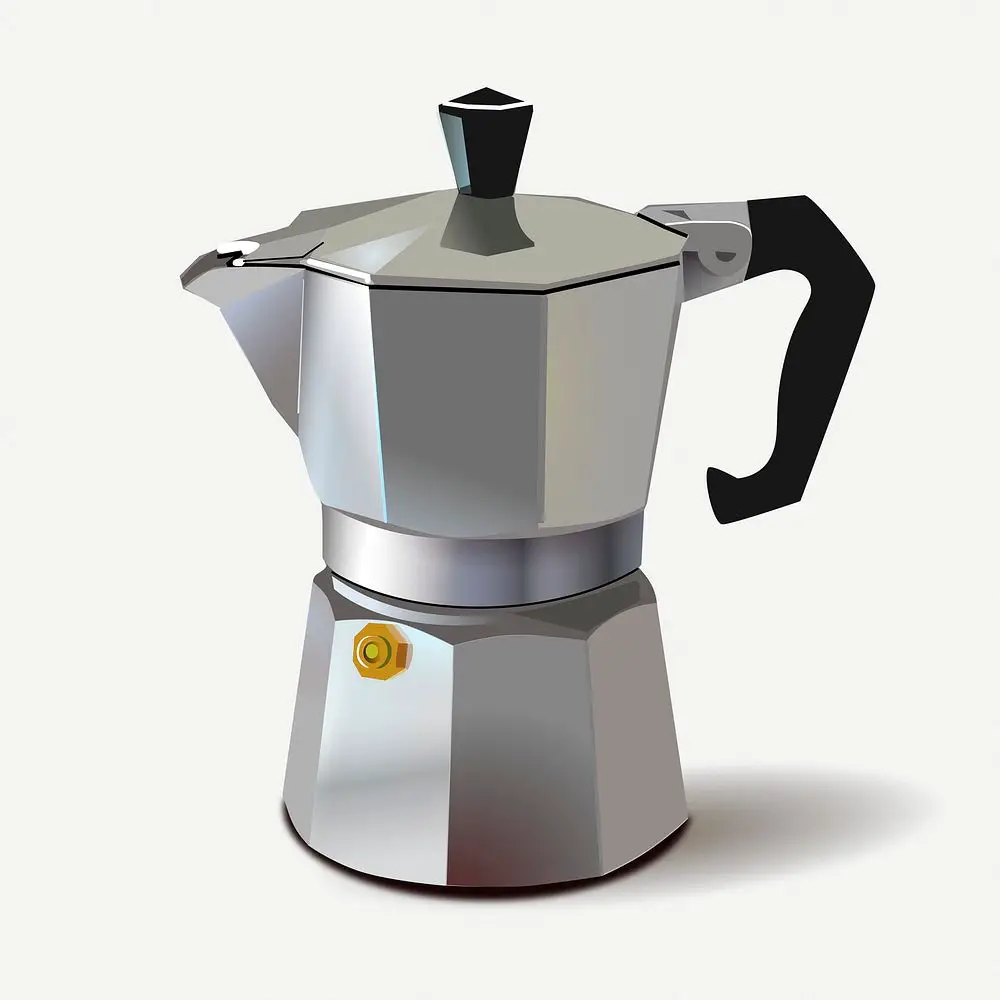
Now, let’s delve into the intriguing question: Can you use a Moka pot on an induction stove? The answer is both straightforward and nuanced.
Traditionally, Moka pots have been a staple in many households for crafting rich, flavorful espresso-like coffee. These stovetop coffee makers rely on heat conduction from a direct flame or electric coil to brew the perfect cup. However, when it comes to induction stoves, the game changes a bit.
Induction stoves utilize electromagnetic fields to heat pots and pans directly. They’re efficient, safe, and increasingly popular in modern kitchens. But here’s the catch: Moka pots are typically made of aluminum or stainless steel, which are not inherently magnetic materials.
Since induction stoves require magnetic materials to generate heat, placing a standard Moka pot on them won’t yield the desired results. The lack of magnetic properties means the stove won’t detect the pot, and thus, won’t activate the heating process.
But fear not, coffee lovers! There’s a workaround. Some manufacturers produce Moka pots specifically designed for induction stoves. These pots feature a layer of magnetic material at the base, allowing them to interact with the induction cooktop effectively.
So, if you’re keen on using your trusty Moka pot with an induction stove, be sure to look for models explicitly labeled as “induction-compatible.” This way, you can enjoy your favorite brew without missing a beat.
In summary, while traditional Moka pots may not work on induction stoves due to their non-magnetic composition, specialized induction-friendly versions are readily available. With the right equipment, you can savor the distinctive taste of Moka pot coffee on your induction stove with ease.
If you’re interested in using a clay pot on an induction stove, you may find our article on clay pot work on induction stoves informative and helpful.
Will a Bialetti Work on an Induction Hob?
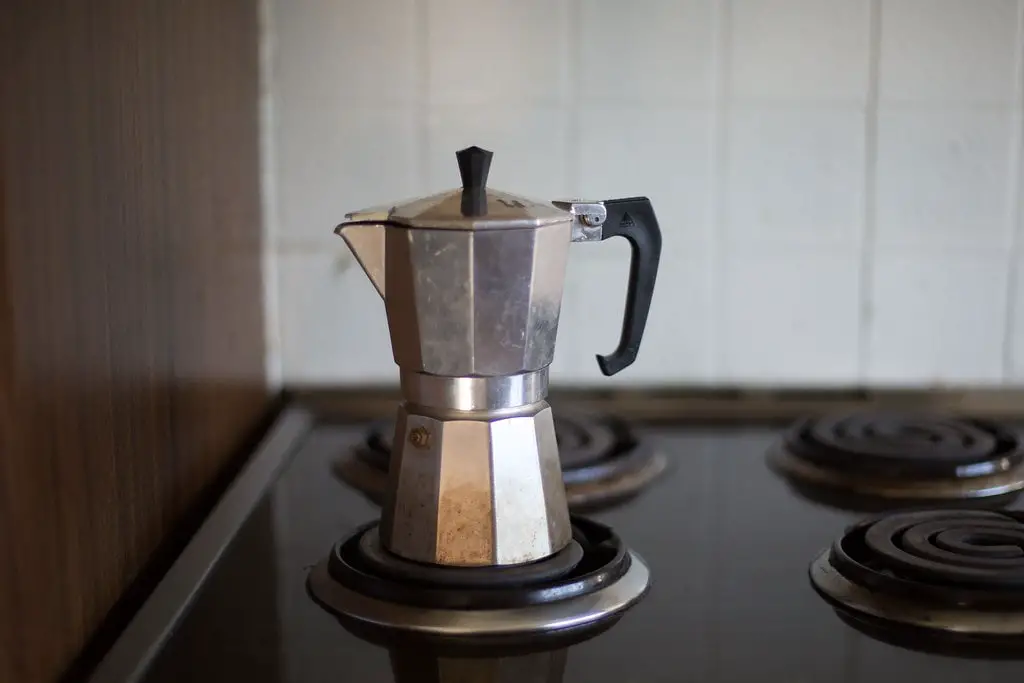
If you’ve ever pondered whether your trusty Bialetti Moka pot can dance on an induction hob, you’re not alone. The marriage of these two kitchen elements isn’t always a seamless waltz, but let’s explore whether your beloved Italian coffee maker can tango with your sleek induction cooktop.
The Bialetti Moka pot, with its iconic octagonal shape and rich history, has been a staple in many households for generations. Its design relies on the heat from a traditional stove burner to brew that perfect cup of espresso-like coffee.
But what about induction hobs? These modern marvels use electromagnetism to heat pots and pans directly, bypassing the need for a traditional burner. The magic happens when the hob detects the presence of ferrous metal, generating heat only within the cookware itself.
Here’s where the plot thickens: the Bialetti Moka pot, while predominantly made of aluminum, often features a steel base. This steel base is crucial because it allows the induction hob to recognize and heat the pot. So, yes, your Bialetti can indeed work its magic on an induction hob.
However, there’s a catch—a small caveat to keep in mind. Not all Bialetti Moka pots are created equal. Some older models or cheaper variations might lack the necessary steel base, rendering them incompatible with induction hobs. So, before you embark on your caffeinated journey, double-check your Moka pot’s base to ensure it’s induction-ready.
In summary, while the Bialetti Moka pot and induction hob may seem like an odd couple at first glance, they can indeed make beautiful coffee together. Just remember to check for that steel base, and you’ll be on your way to enjoying rich, aromatic espresso in no time. Cheers to the union of tradition and modernity in your morning brew.
Which Bialetti is best for Induction?
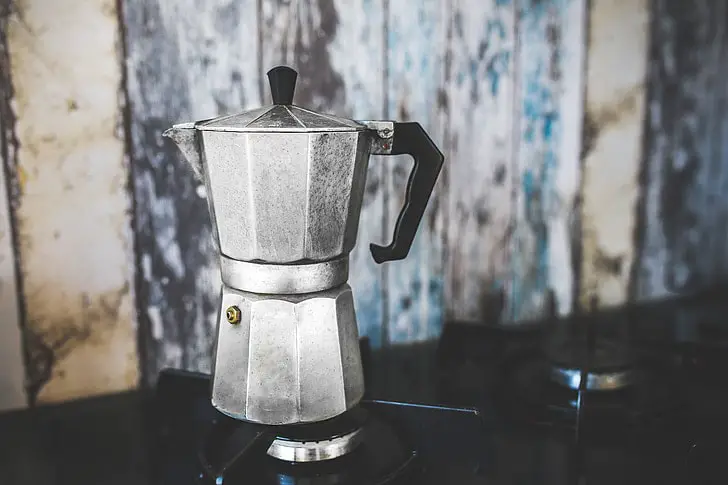
When it comes to finding the perfect moka pot for induction cooktops, the Bialetti Venus Moka Pot stands out as a top choice. Crafted from durable stainless steel, the Bialetti Venus is designed to deliver superior performance while being induction-friendly.
What sets the Bialetti Venus apart is its robust construction and sleek design. Made from high-quality stainless steel, it not only looks outstanding but also ensures longevity and durability. The stainless steel construction also makes it compatible with induction cooktops, allowing users to enjoy their favorite espresso brews with ease.
Another feature that makes the Bialetti Venus a standout choice is its ability to brew rich and flavorful coffee. Thanks to its efficient design, the Bialetti Venus ensures that water is evenly spread throughout the coffee grounds, resulting in a consistently delicious cup of espresso every time.
Moreover, the Bialetti Venus is easy to use and maintain. With its ergonomic handle and easy-to-clean design, it’s perfect for both beginner and experienced coffee enthusiasts alike. Whether you’re brewing your morning pick-me-up or entertaining guests, the Bialetti Venus delivers a satisfying coffee experience.
How To Make Moka Pot Coffee on an Induction Hob?
Now, let’s dive into the delightful process of making Moka pot coffee on an induction hob. This method brews a rich and robust cup of coffee that’s sure to tantalize your taste buds.
Firstly, assemble your ingredients and equipment: freshly ground coffee beans, cold water, and your Moka pot. Ensure that your Moka pot is compatible with induction hobs, as not all are.
Begin by filling the lower chamber of the Moka pot with cold water, ensuring you don’t exceed the safety valve. Then, level off the ground coffee in the filter basket without compressing it.
Now, assemble the Moka pot by screwing on the top chamber securely. Place it on the induction hob, making sure it’s centered and stable. Set the hob to medium heat, allowing for a gradual extraction process without scalding the coffee.
As the water heats up, steam will build, pressurizing the chamber and forcing the water through the coffee grounds. You’ll soon hear the gentle gurgling sound, indicating that the brewing process is underway.
Keep an eye on the process, adjusting the heat if necessary to maintain a steady but not rapid flow of coffee into the upper chamber. This slow extraction ensures the full flavor and aroma of the coffee are captured without any bitterness.
Once the upper chamber is filled with brewed coffee, remove the Moka pot from the heat source promptly to prevent over-extraction. Be cautious as the pot may still be hot.
Give the coffee a quick stir to ensure uniformity of flavor, then pour it into your favorite mug or cup. You’ll notice the rich crema and enticing aroma that characterizes Moka pot coffee.
Finally, savor each sip of your freshly brewed Moka pot coffee, appreciating the craftsmanship and tradition behind this timeless brewing method. You can tailor the flavor to your taste by experimenting with different coffee beans and grind sizes.
In summary, making Moka pot coffee on an induction hob is a simple yet rewarding experience that yields a delicious cup of coffee. With a bit of practice and attention to detail, you’ll master the art of Moka pot brewing and enjoy cafe-quality coffee in the comfort of your own home.
If you’re curious about using non-stick pans on electric stoves, check out our article Can you use nonstick pans on electric stoves?
8 Things To Consider Before Buying A Moka Pot For An Induction Stove:
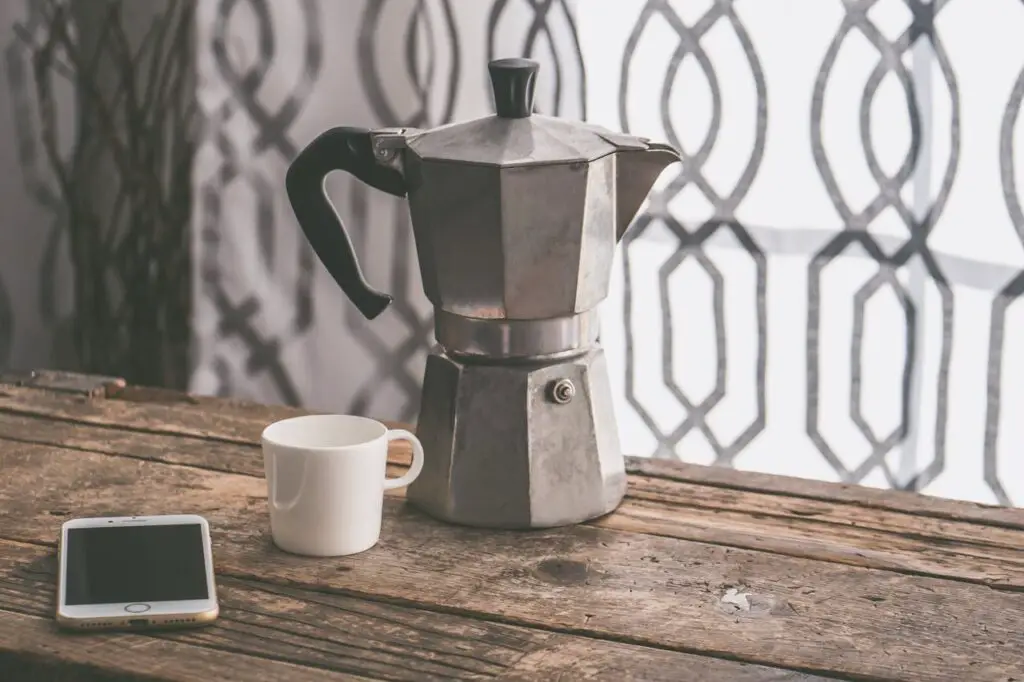
Before purchasing a Moka pot for your induction stove, there are several key factors to mull over. These quaint little coffee makers have their charm, but compatibility matters. Here’s what you should consider:
1. Material Composition
Start by inspecting the material. Traditional Moka pots are crafted from aluminum, which conducts heat well but isn’t induction-compatible. Look for stainless steel variants, which work seamlessly with induction cooktops. They ensure even heat distribution without compromising on durability.
2. Base Design
The base of the Moka pot is pivotal for induction cooking. Opt for a pot with a flat, magnetic base. This design ensures proper contact with the induction surface, facilitating efficient heat transfer. A secure base also prevents wobbling, ensuring safety during the brewing process.
3. Size & Capacity
Consider your caffeine needs. Moka pots come in different sizes, typically ranging from 1 to 12 cups. Select a size that aligns with your daily coffee consumption. Bear in mind that larger pots might not fit well on smaller induction stoves, so measure your burner space beforehand.
4. Quality of Construction
Craftsmanship speaks volumes when it comes to Moka pots. Assess the body quality and attention to detail. A well-constructed pot with tightly sealed joints and sturdy handles promises longevity. Check for smooth edges and a shiny finish, indicative of superior craftsmanship.
5. Brand Reputation
While brand loyalty isn’t everything, it often reflects reliability and customer satisfaction. Research reputable brands known for producing high-quality Moka pots suitable for induction stoves. Read reviews and seek recommendations from fellow coffee enthusiasts to gauge product performance and customer support.
6. Price vs. Value
Price shouldn’t be the sole determinant, but it’s a practical consideration. Set a budget and explore options within that range. Remember, a slightly higher upfront investment in a premium Moka pot may translate to superior performance and longevity, making it a worthwhile investment in the long run.
7. Cleaning & Maintenance
Convenience matters, especially during cleanup. Opt for Moka pots with detachable parts for easy disassembly and cleaning. Stainless steel variants are dishwasher-safe, streamlining maintenance. Additionally, look for pots with rust-resistant properties to maintain their pristine appearance over time.
8. Aesthetics & Design
Let’s not forget aesthetics! Your Moka pot should complement your kitchen decor while exuding timeless charm. Explore different designs, from classic to contemporary, and select one that resonates with your personal style.
By deliberating over these considerations, you can confidently select a Moka pot that harmonizes with your induction stove, elevating your coffee brewing experience to new heights.
Conclusion:
While the Moka pot’s traditional design relies on direct heat sources like gas or flame, there are ways to adapt it for use on induction stoves. By employing an induction-friendly Moka pot or utilizing an induction stove converter disc, coffee enthusiasts can still enjoy the rich, aromatic brew that this classic device produces. Despite the initial skepticism surrounding its compatibility, the ingenuity of modern kitchen solutions has bridged the gap between tradition and innovation.
Ultimately, whether you’re a purist who savours the ritual of brewing coffee on a traditional stovetop or an advocate for the convenience of induction cooking, there’s room for everyone to savour the joys of a freshly brewed cup of Moka pot coffee. With some experimentation and adaptation, the cherished ritual of preparing coffee with a Moka pot can seamlessly integrate into the modern kitchen, ensuring its timeless charm for generations to come.
